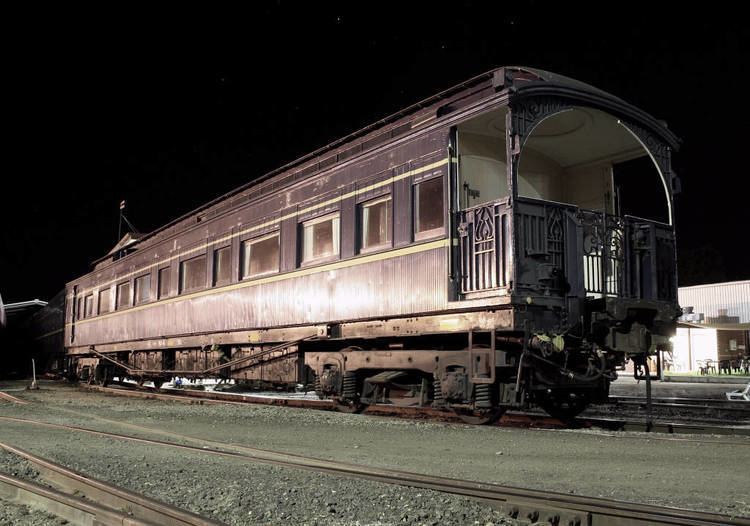The Victorian Railways Royal Train operated to transport members of the British Royal Family on their numerous tours of Australia on the Victorian Railways network. The same carriages were also used for a number of vice-regal trains for the Governor-General of Australia and the Governor of Victoria. The last Royal Train ran in 1988.
Royal trains usually operated with special carriage stock set aside for the purpose. Most trains operated with double headed locomotives to reduce the chance of the train being stranded due to locomotive failure, with a third locomotive running in front of the train to ensure the track was clear. A special headboard with the royal coat of arms was usually affixed to the front of the leading locomotive.
In the history of the Victorian Railways there were five special carriages designated for royal train and other special services, designated State Car 1 through to State Car 5.
The carriages were painted in the standard royal blue with gold trim of the Victorian Railways, with the exception of the 1988 Royal Tour. Operated by VR successor V/Line this trip was operated by two freshly cleaned, partially repainted (below footplate) & polished locomotives in the standard orange and grey livery, with the carriages painted in a one off 'executive' livery of grey and white, with orange and green trim.
State Car 1 entered service in 1890 as Enterprise. It was renamed in 1900 and was scrapped in August 1956.State Car 2 and State Car 3 both entered service in 1901 and were both rebuilt for other uses in 1919.State Car 4 was built in 1912 based on the then state of the art wooden E type carriage design. It featured an observation balcony at one end, Governor's and Lady's bedrooms (which could be separated by doors), dining room, kitchen, Gents and Ladies bathrooms (each with bath, shower and toilet), and accommodation for ladies in waiting and other support staff. A total of 9 sleeping berths were provided. This carriage is owned by VicTrack Heritage and is allocated to the Seymour Railway Heritage Centre collection.State Car 5 was based on the steel air conditioned S type carriage design in 1951. A royal insignia was painted on each side. The carriage featured a kitchen, lounge / dining area, two main bedrooms with ensuite (featuring bathroom with bath, basin, shower and toilet), two sleeping / sitting compartments for attendants, and a third bathroom. In 1954 it was displayed at the Centenary Exhibition. It was repainted into the grey livery in 1988 for the Royal tour of the year, and has since been allocated to the Seymour Railway Heritage Centre collection.Mitta Mitta was converted from BRS 228 for use as a support carriage for State Car 5 on Vice Regal trains in 1994, but was never used in the role. It was fitted with sleeping berths, bathroom, kitchen, and a dining and lounge area.Norman (former Spirit of Progress parlor car) was also used on Royal trains.June 1867: The first Royal train drawn by engine No50, took Prince Alfred Duke of Edinburgh to Ballarat, and then to Castlemaine and Bendigo. Recorded times for the 45 miles between Melbourne and Geelong were 52 to 60 minutes. [Leo J. Harrigan. Victorian Railways to '62. Victorian Railways. 1962. p 269]May 1901 - The first complete Royal train was assembled from special purpose vehicles for the visit of the Duke and Duchess of Cornwall and York (later King George V and Queen Mary). The Royal train travelled to Healesville and other parts of Victoria, and finally to Port Melbourne, where they embarked for the sea voyage to Brisbane.May / June 1920: Prince of Wales (later briefly King Edward VIII) toured the state.7 May 1927: The Duke and Duchess of York (later King George VI and Queen Elizabeth), who were visiting Australia to open the new Parliament House in Canberra, travelled from Melbourne to Geelong with A2 976 and to Seymour on 11 May with A2 948.26–27 October 1934: Duke of Gloucester, (later Governor General of Australia 1945-1947) Bairnsdale to Melbourne for Melbourne Centenary Celebrations.31 October 1934: Duke of Gloucester to Mildura.February / March 1952: Planned tour by then Princess Elizabeth and Prince Phillip, cancelled due to the death of King George VI. Was to be operated by steam locomotive R 704.3–6 March 1954: Queen Elizabeth II accompanied by the Duke of Edinburgh. B class diesel electric locomotives used.2 March 1958: Queen Mother, Ballarat to Melbourne 2 S class1959: Princess Alexandra.18 October 1965: Governor-General Lord Casey from home station of Berwick on his first official visit to Melbourne. State Car No 5 hauled by a diesel electric engine.27 October 1975: Princess Margaret to Moe and return, locomotive L1150.15 April 1983: Diana, Princess of Wales and Prince Charles from Spencer Street to Ballarat (the train returned empty) S. 4500/83. Locomotives S 315 (crew: DR Bill Steedman and FM Danny Hallinan) and S 300 (leading) & S 315 (trailing, hostlers end leading) headed the 3 car train of an AZ car (unknown No), Norman (Saloon trailing) and No 4 State (observation deck trailing) = 3/157tonne, S 311 was the pilot locomotive (DR Kevin Whelan FM Vic Greensill) and ran between 31 and 33 minutes ahead of the Royal Train. Relief locomotive at Bacchus Marsh X 31 (DR Ian R. Barkla FM Trevor Luxford)28 April 1988: Queen Elizabeth II and the Duke of Edinburgh from Spencer Street to South Geelong and return from Geelong to SSS S. 5000/88. Pilot locomotive (DR Brian Ward FM Robert Hosie) Pilot Engine N469 ran 10 minutes ahead of Royal Train. Royal Train Crew (DR Kevin Whelan FM Sean Kelly) Locomotives N471 & N474 Load: ACZ 252 van trailing, No 5 State Car kitchen end trailing, Norman round saloon end trailing. S.5000/88
